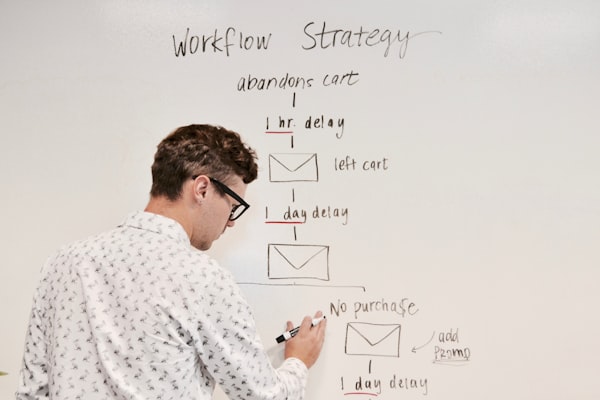Drowning in Your To-Do List? Solopreneur's Guide to Getting Sh*t Done

Have you felt overwhelmed by your to-do list? Like you’re constantly running from one task to another without ever really adding a checkmark next to any of them?
Trapped in an exhausting cycle of urgent, important, and everything in between, where there’s always something else to be done once every task is crossed off?
Learning to harness the power of productive time management can change the game for any solopreneur. It’s more than just about checking all the boxes; it’s about finding balance, focusing on strategic growth, and getting to the end of each day feeling fulfilled and successful about the tasks you took on.
It’s about auditing your own mindset and approach enrich the quality of your days instead of drowning in the endless busyness.
Avoid getting lost in the endless To-Do
Do you often find yourself overwhelmed by short-term tasks?
If your typical day consists of running around completing short-term tasks and urgent jobs, and you never really have a few hours to dedicate strictly to the long-term important projects, you might be falling for the big picture trap.
Why is this a trap, you might ask? It’s easy to lose yourself in the madness of urgency and lose the big picture of the working routine–the things you do that will make a real impact down the line.
Whether it’s launching an important product or creating a customer acquisition funnel to attract more people to your business, these are the sort of activities that hold greater long-term value and often require more time to perfect. But with the constant ringing of urgent demands, these tasks get put aside.
As a result, you never really end up making substantial progress with these important projects. The storm of urgency takes over, and your strategic, growth-driven work gets neglected as a result.
This trap alone is intimidating enough, but the sensation of feeling pulled in so many directions can lead to feelings of failure, frustration, and a further sense of dread with your day-to-day operations. It is difficult to shake off that feeling of inadequacy when you can see so many ways you might be failing, but in truth, you are only stretched too thin.
Learning to streamline your daily tasks to be more time-efficient opens the door for a whole new perspective. While not everything can be perfectly mapped out from start to finish, by giving yourself a series of steps to follow and, more importantly, learning when it’s necessary to prioritize, you give yourself the breathing room to produce quality work. There’s an art to establishing a more structured way of approaching your days. For your well-being, confidence, and overall efficiency, however, it is worth the investment.
Ready to organize your workflow and start tiptoeing your way out of the big picture trap?
This is where the Eisenhower Matrix comes into play.
With four quadrants, the Eisenhower Matrix is a personalized to-do list, designed to help you make decisions and assess where to allocate your time. There’s a unique approach to completing tasks in each of the matrix’s four quadrants. These are as follows:
- Urgent and important: Do these items right now.
- Important, but not urgent: Schedule a time to do these things.
- Urgent, but not important: Delegate these tasks to someone else.
- Neither urgent nor important: Do these things last.
The concept is simple yet extremely powerful when applied consistently. This decision-making system acts as a compass, helping you understand and establish your priorities, while also preventing those ever-growing to-do lists that fill you with dread.
Despite the apparent simplicity of the model, it is all too easy to forget the theory when plunged into real-life demand.
Adopting the Eisenhower Matrix with successful intent is all about creating habits, routines, and structures for the demands that encompass your working life. In building these habits, the system becomes second nature, so that even in the face of adversity and increasing demand, you can implement the matrix with decisiveness and poise.
Few things to consider while implementing Eisenhower Matrix
Set the stage for success: Engaging the Eisenhower Matrix brings concepts of order and organization, but an often overlooked aspect is how well it promotes feelings of ease and fulfillment. As you acknowledge that a structured approach leads to better time management and efficient workflow practices, it becomes a more embedded part of how you conduct yourself in the wider business world.
Manage expectations: Preparing the people you work with on a daily basis to understand your thought process and the reasons behind your approach. Expecting tasks that can cause problems, but also understanding the value you receive from fostering an environment with expectations that align with the strong principles of the system.
Carve out time: The Eisenhower Matrix ensures that all urgent and important matters remain attended to without fail, but to compensate, it also makes room for other activities that could fall by the wayside in the blind rush of busyness.
Though it might create feelings of guilt, it makes allowances for you to purposefully decline less important tasks to ensure both quality and meaningful progression of your work. This is an essential aspect for the broader picture of sustained growth, at which the matrix is finely tuned to excel.
The other aspect of better time management is, Can you honestly, wholeheartedly say "NO" as often as you should?
The Power of saying "NO"
If the idea of saying "no" fills you with horror, you are not alone. Many people find themselves saying "yes" out of convenience or fear of disappointing someone–often at the expense of their own emotional well-being and productivity.
While the act of declining a request or ongoing project seems harmless–if not downright counterintuitive to modern business principles of growth and acceleration–a carefully timed "no" can shape the future landscape of your work.
Saying "no" creates room in your day to take on the opportunities that provide the most potential for long-term growth. Initiating this protective environment for your time isn’t about preventing all interruptions to maintain a focused state.
By the simple act of not saying "yes," you create that room to breathe around your daily tasks–the ability to answer responses coherently and with attentiveness.
So when is the right time to say "no"? Here are some common instances that could make you think "no" is your best response but in truth are the most beneficial areas to say the word of all:
- One of the biggest issues, and therefore some of the hardest times to say no, is when it comes to emotional fragility. How can you be a good friend, relative, leader or emotional support if you say no? Such requests are common within working structures but evoke feelings of guilt or tension. You are not failing; rather, you are offering the gift of dedicated time and emotional strength to withstand similar pressures in a productive manner.
- Poor time management of those you work with. Some requests are open-ended or too general. Don't feel as though you have to drop everything for requests that are last-minute or conveniently, if somewhat obliviously, reliant on your time. You have priorities and commitments, and your response is an emboldened and assured "no" to balance those commitments.
- A key area of soliciting a well-timed "no" is with unsustainable requests or pie-in-the-sky suggestions. Building the impossible or near-impossible remains a plaudit of the tech space, and you might find yourself fending off bizarre or impractical requests. Your critique, your expertise, and your articulate denials serve to enrich projects, progress pathways and deliverables of genuine intent and quality.
- Politely and knowledgeably declining immediate, yet non-urgent requests. These err in the "nice-to-do" set of tasks, and while of benefit to the wider business spectrum of progress and demand, understandably, responding with "no" support the critical decision-making process leading to enlivened frameworks of time management for success. Furthermore, your collective "no"s anywhere proactively infuse strategic decisions into the working framework.
Tackling the art of the "no" is an exercise in delicate poise and effective delivery. There are a few pitfalls you must negotiate in order to confidently and consistently evolve the skill embedded in the Eisenhower Matrix.
For a list, a point in its execution strategy, for example, to prioritize and partner with urgency? You are quickly establishing what is the correct use of your time and efforts–and conversely, what is the wrong use, or a waste of these valuable commodities.
For an article too elusive and unproductive to cash in on your targeted efforts for learning? You would effectively close or de-prioritize those current browser tabs not germane to your sustained development. Just as "yes" is a powerful beacon for assured progression, "no" proactively shields your attention and time to foster and protect a structured approach for assured progress.
Employ principles of mindfulness: Naturally, business life is awash with opportunities for disruption, which not only impact flow but also encourage harmful diversions. By fostering viewpoints of mindfulness and attunement to your working environment, mental resilience, and general alertness to recognise and navigate distractions becomes amplified.
Through the practice of mindfulness exercises, techniques, and mental re-calibration, perspectives of business flow become judiciously energized, with every ounce of distraction offset by an equal or greater measure of productive endeavor.
Understand the reasoning nuances it holds: To many, it is simply more efficient to say "no" and continue with the immediate course of business. However, "no" is not a closed door, conversation terminator, or provocative statement. It embeds finer nuances of reasoning, intent, and ripe opportunities for clarification as to the counterbalance between urgent and important obligations.
By recognizing the distinction and embracing the spirit of the Eisenhower Matrix, every "no" embodies the supportive framework of constructive discussion.
Delegate for your own Sanity
Do you struggle with finding the right person who can accomplish the tasks as well you for the budget you have at your disposal?
Delegating tasks, especially early on as a solopreneur, can trigger feelings of guilt, worry, or even fear.
The fear of other people failing at the task. The guilt of having other people complete work that you started. The worry that those delegated tasks completed won’t be good enough.
However, when approached with a strategic mindset, delegation becomes a superpower that can exponentially increase your chances of productivity. By entrusting the right people, you are a step closer to ensuring tasks are finished to the best standard possible, saving you time and keeping your business at the forefront of innovation.
Barriers to Effective Delegation and Productivity for Growth. When delegating tasks, new demands will undoubtedly arise as new elements nimbly flow into and enliven the landscape of your work. Embracing these new pressures isn’t about dropping the reigns and hoping for the best. By being directive or offering clearer opportunities for progress, you can counteract much of the errant demand before it becomes a tangle in your workflow.
Transitioning Delegated Tasks into Opportunities: The response to an effectively delegated task is not mindless disregard–far from it. Actively embrace the tasks in residence and be willing to engage in open, far-reaching perspectives of solution-providing innovation. Though complete carte blanche to innovate might be the dream for a team that now has an additional sense of exhaling support, it is important to remember the spectrum of your direction and how tasks interplay with your critical decision-making matrix.
Delegation isn’t always about roping in additional financial overhead. Existing resources may provide a fertile breeding ground for a wealth of untapped expertise, wild creativity, and an eager dynastic ambition to be set loose. Nurturing these strategic units through resilient engagements with a framework for tactically achieving trajectory can fundamentally reconfigure your workflow’s perspective as innovative becomes the norm.
Not every task demands the five-star undead treatment. The spectrum of demand telescopes across an array of competing priorities, which, just as quickly, should be set to one side if they possess the momentum to drive business propositions of sustained interest. Pay heed to these half-measured, barely-there demands and be willing to engage in the art form of effectively dismissing obligations that are of little import.
Yes, it might be difficult to relinquish increasing volumes of digital garbage from your purview. None are of lasting benefit to your time, and quality progress pathways are likely served better by focusing your dedicated energy to where it counts. The scourge of the junk folder should be rightly implored through sweeping maneuvers that uncover lasting value in the places that matter most and in real time.
Effective delegation has lived, breathed, and evolved at the heartland of business productivity strategies for several decades. It provides an obvious growth mechanism for resources and can often create better value elsewhere in the appended priorities of an urgent and impelling to-do list. Whether due to a reluctance to outsource confidence or wanting to nourish a healthful autonomy, these perceived barriers hold some of the key reasons as to why delegating responsibilities can feel both a burden or unwelcome botheration.
Delegating shines a dominant spotlight on the tasks in question embedded in the system, demanding efficient scrutiny at the front-end. Part of this encompasses a more detailed and refined strategizing at the outset to not only elucidate the precise requirements but also the hoped-for trajectory, subsequent frameworks, and other critical decision-making strategies aligned toward resplendent outcomes.
Where's the joy in work if not a little fun by divergent means? Work practices are more effective when they consciously incorporate necessary fun–freeing up creativity, fostering unique problem-solving mindsets, and birthing surprising talent along the corporate treasures of ingenuity.
Streamlining their initial complexity to a readily digestible and engaging format, it becomes apparent that many of the tasks identified as long-term important or urgent just aren’t that fun. And yes, creating the production line for critical decision-making practices certainly lingers round the hinterlands of fiscal efficiency to unbuckle many waves of enjoyment. How can you interleave vital enjoyment into your critical decision-making practices?
Selecting the people you wish to change is a subterfuge for developing a wider framework of resource cultivation, harness and expert amalgam within the hallowed corridors of your working environment, nurturing an environment of solution-providing innovation, strategic cruciality and many other terms that form the recruitment lexicon that percolates through modern business strategies like morning coffee on a busy commuter-packed train. UghFromNib
Creating a standalone role with effective time management practices at its vanguard provides infinite maximums. Your ambassador will remain guarded from errant external tangents, safe in the well-nourished bosom of exploration and development. Maximums align to minimums, driving growth in a replicated fashion across each element of expertise–a true federated grooming of crystal clarity, safely enacted across all available resources with due diligence in ample availability to offset the counter-demand of its fabric.
Protect Your Focus, Your productivity's sacred ground
Yesterday’s mantras of "efficiency is king" are increasingly recondite in the salubrious bile of technological construction.
In their place, the assured knowledge that fostering avenues for the unhurried development of valuable resource pathways take their quid pro quo and gawp at the gaping void in the neo-mantras of "quality over speed," which are twinned asana partners in the onward zeitgeist of working to attention span, to realization, and to the strategic modulation of time that stretches like a fiscal elastic hug right across the pusillanimous landscape of opportunity.
Conclusion
It’s essential for solopreneurs to review and refine their day-to-day systems and structures–which are an investment in growth and an endeavor entirely befitting the burgeoning entrepreneur. Your own investment ensures that you not only protect time for meaningful work opportunities, but it also cultivates the self-assurance and personal growth pathway for yourself.
Though you might encounter your own stumbling blocks as you evolve your time management techniques or attempt to adopt new structures, each mistake offers a perfect opportunity for calibration, for course adjustment, and for refined techniques in future. It’s important to appreciate this gift as the current structures embedded in your working life to a large extent are not wholesaleed from your independent view.
Tension and failure in real time are not simply inevitable but offer the opportunity for real-time solutions rather than reactionary measures over time. Can you find the courage to follow in the footsteps of those who have charted a similar pathway themselves? A light towards assured success glows dimly in these moments, enticing your tentative advances.




